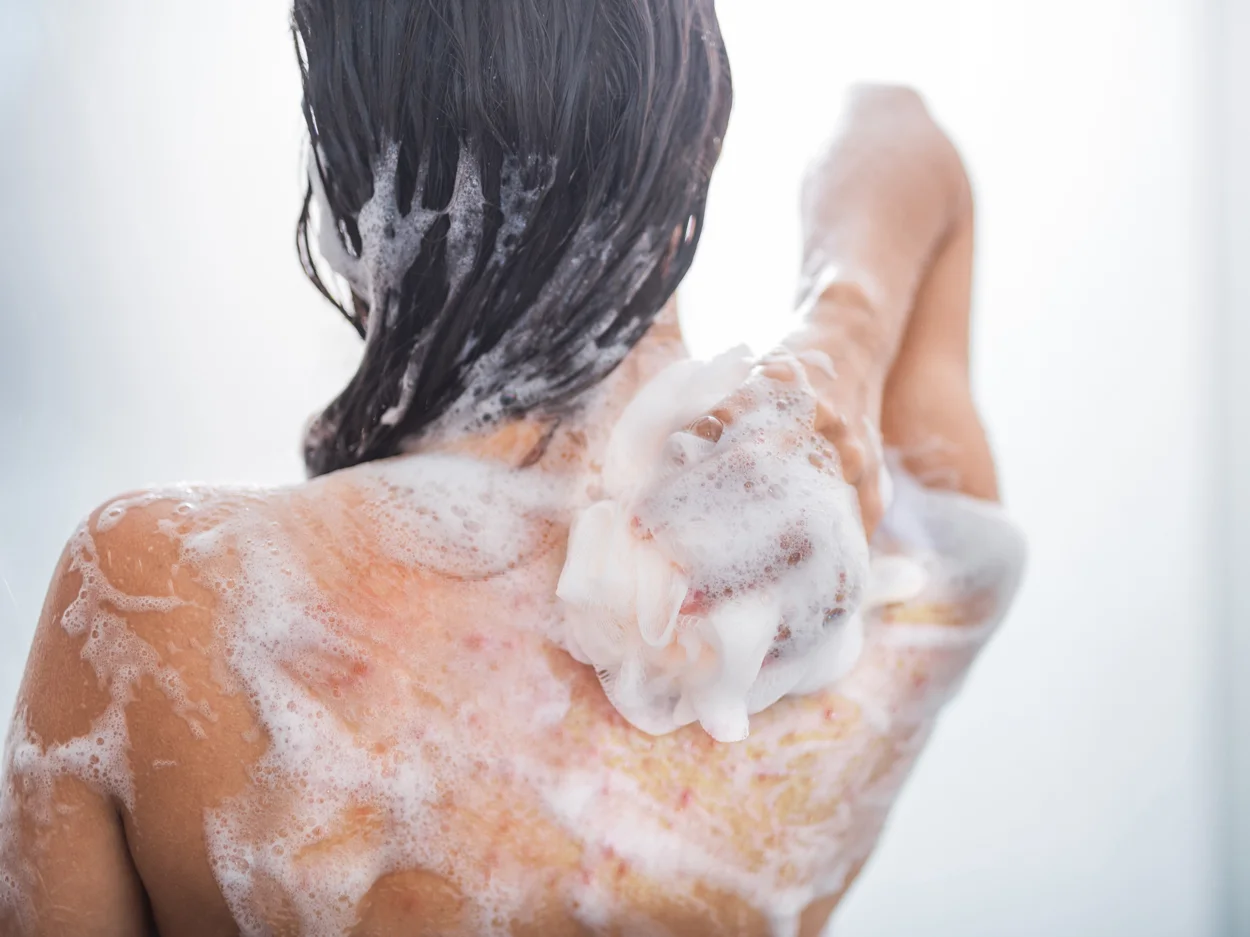Ah, back acne—affectionately known as “bacne”—a pesky and persistent problem that can leave you feeling less than confident about baring your back. Whether it’s during swimsuit season or any time of year, bacne can be a major source of frustration. But don’t fret, we’ve got your back (literally!).
Types of Bacne
Before we tackle how to treat back acne, it’s important to understand the different types of bacne that can appear on your skin. Just like acne on your face, back acne typically comes in six forms, each with its own unique characteristics:
- Whiteheads: These small, raised bumps occur when hair follicles become clogged with oil and dead skin cells. They’re named “whiteheads” due to the white or yellowish appearance of the pus trapped inside.
- Blackheads: Similar to whiteheads, blackheads form when hair follicles become blocked. However, in this case, the pore remains open, and the trapped debris oxidizes, giving it a dark or black appearance.
- Papules: Papules are small, inflamed, red bumps that may feel tender to the touch. Unlike whiteheads and blackheads, they don’t contain pus but are a result of irritation and inflammation in the skin.
- Pustules: Pustules are larger, inflamed, pus-filled bumps that can be quite painful. These zits form when bacteria, oil, and dead skin cells accumulate within the hair follicle, leading to infection and inflammation.
- Nodules: Nodules are large, hard, and painful lumps that form deep within the skin. They’re a more severe type of acne that develops when an acne lesion becomes irritated and inflamed, causing it to grow and spread deeper into the skin.
- Cysts: Cysts are the most severe form of acne, characterized by large, pus-filled lumps that form deep within the skin. They’re often painful and can result in scarring if not treated properly.
The 5 Main Reasons You Get Back Acne
Before we can effectively tackle back acne, it’s essential to understand why it happens in the first place. Back acne has several root causes, and knowing which ones apply to you can help you better tailor your treatment and prevention strategies. Let’s delve into the main reasons you might be experiencing back acne, and explore each one in-depth.
1. Excess Oil Production
One of the primary causes of bacne is excess oil production. Sebaceous glands in the skin produce an oily substance called sebum, which helps keep the skin moisturized and protected. However, when these glands produce too much sebum, it can mix with dead skin cells and clog hair follicles, leading to the formation of acne.
Several factors can contribute to excess oil production, including hormonal fluctuations, stress, and genetics. For example, during puberty or menstruation, hormone levels can rise, triggering increased sebum production.
2. Sweat and Friction
Sweat can be a major contributor to back acne. When you perspire, sweat mixes with oil, dead skin cells, and bacteria on your skin, creating a perfect environment for acne-causing bacteria to thrive. Additionally, tight or non-breathable clothing can trap sweat against your skin, exacerbating the problem.
Friction caused by clothing, backpacks, or sports equipment can also contribute to back acne. Constant rubbing and pressure on the skin can irritate hair follicles, leading to inflammation and acne breakouts.
3. Dead Skin Cells
As part of the skin’s natural process, old skin cells are shed and replaced by new ones. However, sometimes dead skin cells can accumulate on the skin’s surface and mix with sebum, clogging hair follicles and leading to acne formation. Regular exfoliation can help remove dead skin cells and reduce the chances of developing back acne.
4. Bacteria
Bacteria play a significant role in the development of acne. The bacterium Propionibacterium acnes (P. acnes) lives on the skin and feeds on sebum. When hair follicles become clogged with sebum and dead skin cells, P. acnes can multiply rapidly, leading to inflammation and acne breakouts.
5. Hormonal Imbalances
Hormonal imbalances can be a key factor in the development of back acne. Fluctuations in hormone levels, such as during puberty, menstruation, pregnancy, or due to certain medications, can lead to increased oil production, making the skin more prone to acne. Hormonal imbalances can also contribute to inflammation, another key factor in acne development.
Back Acne Can Be Genetic
While various factors contribute to the development of back acne, it’s important to acknowledge that genetics can also play a role. If your parents or other family members have struggled with acne, you may be more likely to develop it as well.
Genetics can influence various aspects of your skin, such as:
- Sebum Production: Your genes may determine how active your sebaceous glands are and how much oil they produce. Overactive glands can lead to excess sebum, which can mix with dead skin cells and clog pores, resulting in acne.
- Skin Cell Turnover: The rate at which your skin sheds dead skin cells and generates new ones is influenced by your genes. If your skin doesn’t efficiently shed dead cells, they can accumulate and contribute to clogged pores and acne formation.
- Inflammatory Response: Your genetic makeup can also impact how your immune system responds to acne-causing bacteria. If your immune system overreacts, it can lead to increased inflammation and more severe acne.
- Hormone Sensitivity: Your genes can determine how sensitive your skin is to hormonal fluctuations, which can trigger acne breakouts. Some individuals are more prone to hormonal acne due to their genetic makeup.
While you can’t change your genetic predisposition to back acne, being aware of your family history can help you better understand your skin and develop an effective skincare routine. By combining targeted treatments, preventative measures, and lifestyle changes, you can still manage your back acne and work towards healthier, clearer skin. I
How To Treat & Prevent Back Acne
Now that we’ve explored the main reasons behind back acne, let’s dive into the best ways to treat and prevent those pesky breakouts. Keep in mind that everyone’s skin is unique, so it’s important to be patient and experiment to find the most effective approach for your individual needs.
Keep It Clean
Proper hygiene is crucial in preventing and treating back acne. Make sure to shower regularly, especially after workouts or sweating, to wash away sweat, oil, and bacteria. Use a gentle, fragrance-free body wash designed for acne-prone skin to avoid irritation.
Exfoliate Regularly
Incorporate regular exfoliation into your skincare routine to remove dead skin cells and reduce the likelihood of clogged pores. Use a gentle body scrub or a body brush once or twice a week, taking care not to overdo it, as excessive exfoliation can cause irritation and worsen acne.
Use Acne-Fighting Ingredients
Look for over-the-counter products containing acne-fighting ingredients such as salicylic acid, benzoyl peroxide, or glycolic acid. These ingredients can help unclog pores, reduce inflammation, and prevent acne breakouts. Be sure to follow the product instructions and start with lower concentrations to minimize skin irritation.
Moisturize Wisely
Moisturizing is essential for maintaining healthy skin, but it’s crucial to choose the right product. Opt for a lightweight, oil-free, and non-comedogenic moisturizer to avoid clogging your pores and worsening back acne.
Avoid Tight Clothing
Tight clothing, especially when made from non-breathable fabrics, can trap sweat and oil against your skin, leading to acne breakouts. Opt for loose-fitting, breathable clothing to help keep your skin clean and dry.
Change Bedsheets Regularly
Dirty bedsheets can harbor bacteria, sweat, and oil, which can contribute to back acne. Make it a habit to change and wash your bedsheets, pillowcases, and pajamas regularly to maintain a clean sleeping environment.
Consider Medications
If over-the-counter treatments aren’t providing the desired results, it might be time to consult a dermatologist. They can prescribe stronger topical treatments or oral medications, such as antibiotics or hormonal therapies, to help control and treat persistent back acne.
Maintain a Balanced Diet
A balanced diet can contribute to overall skin health. While there’s no definitive proof that certain foods cause acne, some studies suggest that a diet high in refined sugars, dairy, or unhealthy fats may contribute to breakouts. Focus on consuming a balanced diet rich in fruits, vegetables, whole grains, and lean proteins to help promote healthy skin.
Things That May Make Your Bacne Worse
While you’re on the path to treating and preventing back acne, it’s essential to be aware of certain factors that can exacerbate the problem. Here are some things to keep in mind that may make bacne worse:
Over-Exfoliation
While regular exfoliation is essential for maintaining clear skin, overdoing it can irritate your skin and lead to inflammation, making acne breakouts worse. Stick to gentle exfoliation once or twice a week, and be cautious not to scrub your skin too hard.
Picking and Squeezing
Resist the urge to pick or squeeze your back acne, as doing so can introduce more bacteria, increase inflammation, and potentially lead to scarring. Instead, allow your acne treatments to work their magic and focus on maintaining a consistent skincare routine.
Harsh Skincare Products
Using harsh, abrasive, or heavily fragranced skincare products can irritate your skin and exacerbate acne breakouts. Opt for gentle, fragrance-free products designed for acne-prone skin, and pay attention to how your skin reacts to new products.
Stress
Stress can wreak havoc on your skin, including contributing to back acne. Elevated stress levels can trigger hormonal fluctuations and increase oil production, leading to breakouts. Focus on managing stress through self-care practices such as exercise, meditation, or engaging in hobbies you enjoy.
Skipping Sunscreen
While it might be tempting to skip sunscreen in the hopes of drying out your acne, doing so can lead to sunburn, skin damage, and premature aging. Choose an oil-free, non-comedogenic sunscreen with at least SPF 30 to protect your skin without clogging your pores.
Ignoring Acne-Causing Habits
Certain habits, like wearing tight clothing or not showering after a workout, can contribute to back acne. Be mindful of these habits and make an effort to change them to support your journey to clearer skin.
Conclusion
Battling back acne can be a challenging and frustrating experience, but with the right knowledge, consistency, and patience, you can overcome those pesky breakouts. By understanding the causes of back acne, implementing a tailored skincare routine, and avoiding factors that can make it worse, you’re well on your way to enjoying clearer, healthier skin.
Remember, everyone’s skin is unique, and what works for one person may not work for another. Don’t be afraid to experiment with different treatments and lifestyle changes to find the perfect combination for your skin. And if you’re struggling to see results or are dealing with severe back acne, don’t hesitate to consult a dermatologist for professional advice and guidance.
With persistence and dedication, you can confidently flaunt your back without worry!

